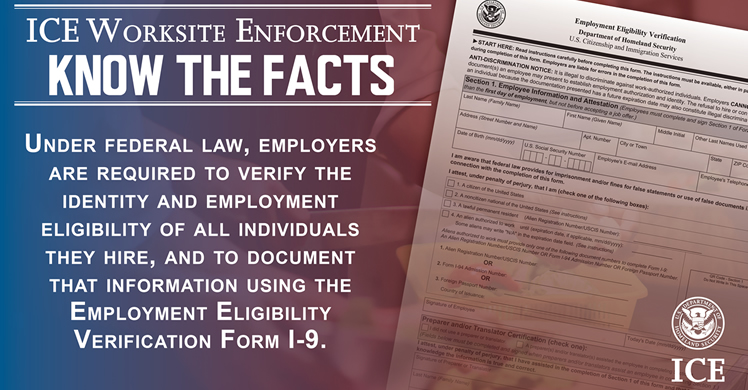Archived Content
In an effort to keep ICE.gov current, the archive contains content from a previous administration or is otherwise outdated. This information is archived and not reflective of current practice.
Worksite enforcement targets employment law violators
Ensuring each of its employees is legally authorized to work in the United States is one of many responsibilities facing every American business, from small start-up operations to our country’s largest and most prosperous corporations.
Tasked with enforcing the business community’s compliance with federal employment eligibility requirements, U.S. Immigration and Customs Enforcement (ICE) Homeland Security Investigations (HSI) developed a comprehensive worksite enforcement strategy that targets employers who violate employment laws.
This strategy incorporates a three-prong approach to conduct worksite enforcement: compliance, through I-9 inspections, civil fines and referrals for debarment; enforcement, through the arrest of employers, knowingly employing undocumented workers, and the arrest of unauthorized workers for violation of laws associated with working without authorization; and outreach, through the ICE Mutual Agreement between Government and Employers (IMAGE) program, to instill a culture of compliance and accountability.
“HSI prioritizes violators who abuse and exploit their workers, aid in the smuggling or trafficking of their alien workforce into the United States, create false identity documents or facilitate document fraud, or create an entire business model using an unauthorized workforce,” said HSI Acting Executive Associate Director Derek Benner. “Further priority is given to looking closely at those companies or industries that are deemed national security or critical infrastructure interests.”
From an operational standpoint, each worksite enforcement investigation is unique. Many factors are considered and, depending on the level of cooperation and culpability, the final outcome for the company and its employees will vary from case to case.
For example, a recently completed investigation of Asplundh Tree Experts Co., one of the largest privately-held companies in the United States, revealed a scheme to unlawfully employ aliens, in which the highest levels of Asplundh management remained willfully blind while lower level managers hired and rehired employees they knew to be ineligible to work in the United States.
The company pleaded guilty and was ordered to pay a monetary forfeiture judgment in the amount of $80 million – the largest judgment ever handed down in a worksite enforcement investigation. They are also required to abide by an administrative compliance agreement, as set forth by HSI Philadelphia, the local jurisdiction for the company’s headquarters.
Pursuant to a separate civil settlement agreement, Asplundh will pay an additional $15 million to satisfy civil claims arising out of their failure to comply with immigration law, bringing the total cost of this illegal scheme to $95 million.
An effective worksite enforcement strategy must address both employers who knowingly hire illegal workers, as well as the workers themselves. In worksite cases, ICE investigators adhere to high investigative standards, including the following: ICE will look for evidence of the mistreatment of workers, along with evidence of trafficking, smuggling, harboring, visa fraud, identification document fraud, money laundering and other such criminal conduct.
Worksite enforcement investigations often involve violations of other criminal statutes by employers and may also reveal widespread employee abuse. For example, many of the agency’s worksite investigations uncover instances of alien smuggling, alien harboring, document fraud, money laundering, or worker exploitation. HSI also investigates employers who use force, threats or coercion – such as threatening to have employees deported – to keep unauthorized alien workers from reporting substandard wages or unsafe working conditions.
By uncovering such violations, HSI is sending a strong deterrent message to all industries that companies who knowingly hire unauthorized workers will be investigated resulting in possible civil or criminal penalties.
Employers who are seeking assistance with ensuring their companies are compliant can seek Department of Homeland Security (DHS) certification through the IMAGE program. Participants have pledged to maintain a secure and stable workforce, including outreach and education designed to prevent unlawful hiring practices.
After first completing a self-assessment questionnaire, employers must enroll in the DHS E-Verify program, establish a written hiring and employment eligibility verification policy and submit to a company-wide form I-9 inspection.
As of Sept. 1, 2017, there are 114 charter members; four endorsees, which are associations who promote IMAGE requirements to their members; 287 certified members (certified after 2011); and 183 companies who have signed agreements and are in the process of becoming certified members.


